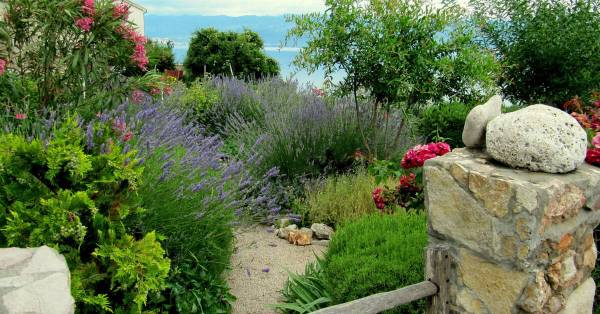
Water saving in the garden is not just limited to desert plants and gravel-covered landscapes. Even vegetable and flower gardens can benefit from some of the methods used to conserve water in the garden.
With the premium put on fresh water around the world and the over-use of it by many – not to mention the fact that some areas just don’t have a lot of water to begin with – the impetus to conserve has grown. Urban area landscaping accounts for 25% of most municipality’s use of water. This water usage is often targeted by city and county ordinances.
Xeriscaping
This is the traditional method of saving water in the yard and garden. Xeriscaping is simply planning and designing a landscape that minimizes water use by creating non-water areas, using low-water plants, and maximizing the amount of indigenous plant life used. Many people have found that simply switching to a more local, drought-tolerant grass for their lawn has lowered their water usage (and its bill) by half.
Drought Tolerant Plants
Although we traditionally think of desert plants as being drought-tolerant, they aren’t the only ones. Some drought-tolerant plants are beautiful and will do well by any garden or landscape. Ones to consider include Echinacea flowers, ornamental grasses, bush-style swamp grass, and many types of trees.
The best way to find drought-tolerant plants for your area is to just drive along local roadways and take photos of what naturally grows wild. Many beautiful plants are growing all around you and they’re all perfectly suited to your climate. From there, it’s a matter of identifying their names and finding a nursery that sells them.
In general, perennial plants tend to be more drought-resistant than annuals.
Mulch in the Garden
The heavy use of mulch, thickly laid around the more water-needy plants, is a great way to retain soil moisture and reduce the amount of watering required. Many gardeners use mulch instead of grass or gravel to surround plants and even create soft-toned walkways (bark is popular for this). Natural mulch absorbs water, helps keep the soil cooler, and reduces water loss through evaporation.
Healthy Garden Soil
The healthier your soil is, the better it will retain water in a way that’s beneficial to the plants in it. Obviously, gardeners are well aware of the need to have proper drainage, but good drainage is accomplished by allowing water to go down, not out and away. The deeper water can penetrate easily, the more that will be retained by the local soil for use by plants that can reach for it. The deeper your plants’ roots, the more drought-tolerant they’ll be.
Tips for Water Conservation in the Garden
Water close to the ground rather than with tall sprinklers. This reduces evaporation loss and helps with other problems like fungus and infection. Watering in the morning or evening, rather than in the heat of midday, also reduces evaporation loss.
Using the right plants in the right areas, such as keeping shade-loving plants in the shade, also reduces water usage. Plants that aren’t happy in full sun will require more water to stay healthy.
Want to learn more about creating water saving gardens?
Check out these resources:
Water Conservation in the Vegetable Garden [PDF] by Colorado State University Extension
Landscape Water Conservation: Xeriscape by Texas A&M University Extension

I live in a very dry area and need to choose my plants and garden options accordingly. I didn’t know that there was such a variety apart from dessert plants that are drought resistant. I will look more into perennial plants for my garden!